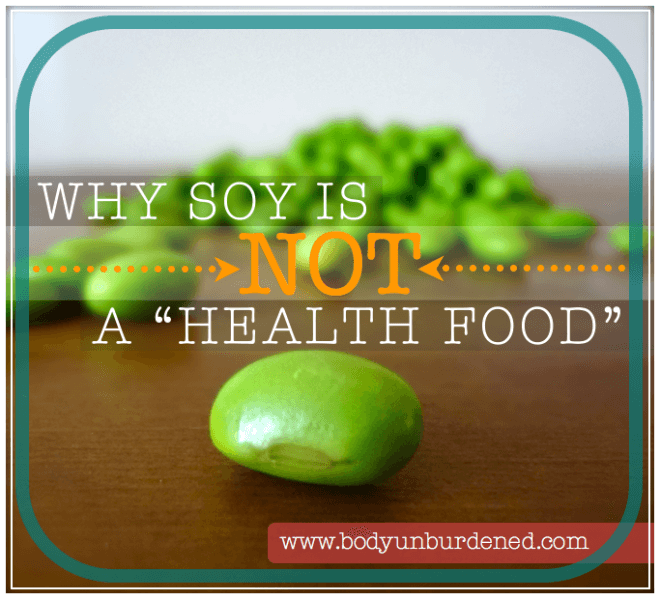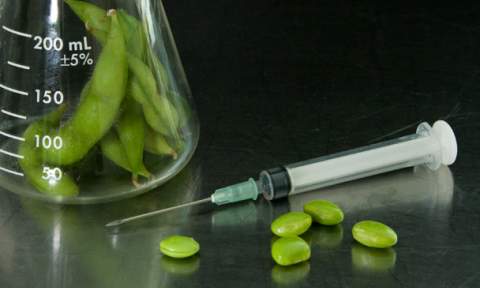First in USA 91% of soy is GMO food.
When I think of soy and its so-called “health benefits,” I immediately see a 15-year-old version of myself eating breakfast at the kitchen table in the house where I grew up. It is a pleasant memory… until I get back around to the whole soy part. You see, when I was a teenager, I was health-conscious yet lacked any real knowledge of the food system and nutrition. I mean, I thought non-fat yogurt containing artificial coloring and sweeteners was healthy (get the gist?). And it was at this point in my life that I drank a glass of soy milk everyday with my breakfast.

When I think of soy and its so-called “health benefits,” I immediately see a 15-year-old version of myself eating breakfast at the kitchen table in the house where I grew up. It is a pleasant memory… until I get back around to the whole soy part. You see, when I was a teenager, I was health-conscious yet lacked any real knowledge of the food system and nutrition. I mean, I thought non-fat yogurt containing artificial coloring and sweeteners was healthy (get the gist?). And it was at this point in my life that I drank a glass of soy milk everyday with my breakfast.
And I mean everyday.
I was religious about it: I needed to get all of those heart-healthy benefits that I had read about on the carton!

*palm to face*
I know a lot of valuable things now that I wish I had known back then: never attempt to pierce your own ear; self-tanner rarely tuns out well (and that brand you use is chock-full-o-nasties); “popularity” is a high-school social construct that has no real meaning; boys are silly and gross until around the age of 23 (and then most are still silly and gross); soy is not a health food.
While I am happy to have learned some of these facts from firsthand experience, this does not apply to the last. This is because I can look back on my soy-milk-drinking phase of my life and make a clear connection between my soy intake and my irregular menstrual cycle, something that I was told was “normal” and given birth control pills at the ripe age of 15 to “fix.”
But what needed to be fixed was my diet! I cannot explain how frustrated it now makes me that the first question out of the doctor’s mouth was not “Does your diet contain soy?” as it should have been since soy profoundly affects hormones and the menstrual cycle, and is utterly ubiquitous in today’s food system.
This is not the only detrimental health effect of soy, however.
The dangers of soy
The Whole Soy Story by Dr. Kaayla Daniel references thousands of scientific studies that link soy to:
- Malnutrition
- Digestive disorders
- Immune deficiency
- Thyroid malfunction
- Declining brain function and behavioral problems in children
- Increased infertility
- Early-onset puberty in children
- Increased cancer risk
- Increased risk of heart disease
These health maladies result from a number of different properties of soy:
- Phytoestrogen is a plant-based estrogen that mimics true estrogen, and soy contains more than any other source. Elevated estrogen levels can lead to breast cancer, early-onset puberty, infertility, decreased libido, and uterine fibroid tumors. Amazingly, the Phytoestrogens consumed by infants on soy-based formula (approximately 20–25% of U.S. infants receive at least some soy-based formula in their first year) is equal to taking 4 birth control pills everyday.
- Goitrogens suppress the normal functioning of the thyroid, which regulates your metabolism. Furthermore, an Isoflavone called Genistein inhibits your thyroid’s natural hormone production and ability to absorb nutrients. A damaged thyroid may cause weight gain, fatigue, irregular menstruation, and loss of cognitive function.
- Phytic acid blocks your digestive system’s ability to absorb nutrients. For this reason, many studies have linked soy to malnutrition.

Furthermore, GMO soy poses its own health risks. GMO soy was created to impart resistance to the toxic herbicide Roundup. While this increases farming efficiency and provides consumers with less expensive soy, as a result, soy is loaded with this toxic pesticide. GMO soy also contains genes from bacteria that produce a protein that has never before been part of the human food supply. This protein has been linked to an increase in allergies. Furthermore, the only published human feeding study on GMO foods ever conducted verified that the gene inserted into GMO soy transfers into the DNA of our gut bacteria and continues to function. This means that years after we stop eating GMO soy, we may still have the potentially allergenic protein continuously produced within our intestines. With 91% of soy grown in the US genetically modified, this is very concerning.
Fermented soy vs. unfermented soy
To understand the controversy surrounding soy, you must understand the difference between unfermented soy (which I have been and will refer to simply as “soy”) and fermented soy.
Fermented soy is central to many traditional Asian diets and is primarily consumed as a condiment. As such, in all, Asians typically only eat 2 teaspoons of fermented soy a day. Fermentation destroys the above “anti-nutrients” in soy, making it safe to consume in moderation. For this reason, fermented soy does have health benefits when consumed in small quantities, as in traditional Asian diets.
But the rest of the world is not consuming fermented soy. And the rest of the world is not eating 2 teaspoons a day. And to add insult to injury, the rest of the world is primarily eating GMO soy.
(S)oy vey!
So why is soy everywhere?
First of all, many people still believe that soy is a “health food” and demand thus remains high. It is important to note that studies that praise the health benefits of soy typically do not distinguish between fermented and unfermented soy products.
Secondly, soy is a cheap and easy filler for food companies to include in processed foods. As Food Renegadeexplains in her article The Dangers of Soy:
“The soybean was a modest and unpopular crop until food manufacturers intent on creating cheap vegetable oils convinced the U.S. government to start subsidizing it. The soy was turned into oil, and the industry was left with an industrial waste product. Then somebody had a brilliant idea: Let’s take this industrial waste product full of toxins and carcinogens — isolated soy protein — and turn it into food that people will eat!”
So what can you do?
Avoid it!
Plain and simple, read those ingredient labels. Although really, soy is just another reason to cut processed foods out of your life.
If you are relying on soy as a source of vegan protein, it’s time to diversify. There are plenty of other sources of vegan protein out there: nuts, seeds, green leafy vegetables, quinoa, beans, sprouted grains. If you are a soy milk drinker, consider making a switch to other non-dairy milks such as coconut, hemp, or almond milk (just be sure to avoid this carcinogen hiding in your milk).
Sources and further reading:
- Food Renegade, Dangers of Soy
- DrKaaylaDaniel.com and TheWholeSoyStory.com
- Dr. Kaayla Daniel, The Whole Soy Story
- The Healthy Home Economist, 170 Scientific Reasons to Lose the Soy in Your Diet
- Underground Health Reporter, Fact or Myth: Is Soy Bad For You?
- Wellness Mama, Is Soy Healthy?
- Dr. Mercola, This “Miracle Health Food” Has Been Linked to Brain Damage and Breast Cancer
- Dr. Mercola, Genetically Engineered Soybeans May Cause Allergies
- http://bodyunburdened.com/soy-unhealthy/
No comments:
Post a Comment